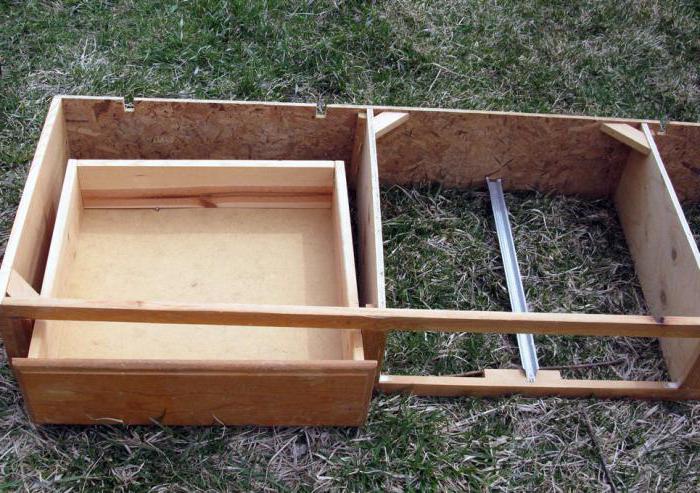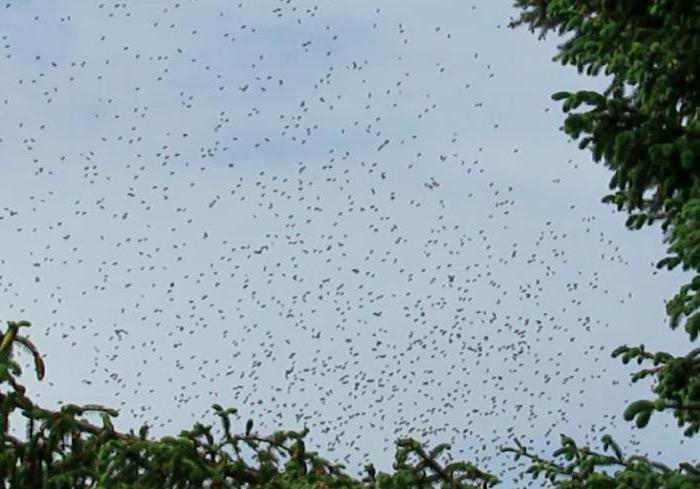Modern technologies and means of organizing the life of honey bees make it possible to achieve optimal results in breeding their families. Partially revolutionary were the methods for constructing frame hives. However, in former times, the breeding of bee colonies was carried out by swarming. That is, the apiary was expanding due to the settlement of wild individuals in homes. Nowadays, swarm fishing as a way of breeding families is not so relevant, however, its effectiveness has not been canceled.
Of course, this technique carries some dangers, but subject to certain rules developed by experienced beekeepers, considerable benefits can be drawn from it. At the same time, it is important to determine the goals of the “hunt”, since stray bees require a special approach in their further maintenance.
How to catch a swarm of bees?
The whole fishing process consists of two components - attracting and taming insects. The main tool of this event is the house for the bee - the frame design is most often used, although there are other options. But if such housing in providing home breeding can be used in a completely new, uninhabited form, then for working with stray individuals, the already used trap for bees is preferable . You can make a new house with your own hands, but in this case you will have to make a lot of efforts to make it truly attractive to the swarm.
The presence of a smoker, facial mesh and other devices are only part of the conditions that can increase the chances of successful fishing. Now it is worthwhile to consider in more detail the methodology for creating a trap recommended by experienced beekeepers.
Making traps for bees
A typical layout involves the use of four honeycomb frames that form the base of the hive. The gaps between them are usually about 12-13 mm. Framed together with the use of bars and nails. Again, the typical format of the plank is 1x2x14 cm. If you correctly assemble the structural elements, you will get a reliable and strong trap for bees. It’s not difficult to do it yourself - the finished framework should be nailed with the help of bars to the base of the future hive. The third bar will act as an element of rigidity - it should be nailed obliquely in relation to the frame. It is recommended that the central parts of the extreme bars be additionally connected with a cord, which will also give the house strength.
How to equip beehives?
Stray bees, like their home relatives, are very sensitive to food. Therefore, the internal content of the house is a crucial task. And precisely for this reason, many experts advise to use lived hives for "hunting". But not every novice beekeeper has such a snap. Accordingly, in most cases, swarm fishing is carried out with the use of new houses, which should be properly provided with food and additional devices.

Without fail, each new hive is equipped with frames with honeycombs, food and wax. Select the volume of filling should be depending on the size of the tap hole. After the insects fill the free surfaces of the frames, it will be possible to review the provision of the trap. It should also be noted that swarm fishing involves fumigation with a smoke. By the way, the absence of habitable hives does not at all preclude the possibility of placing a new frame with the available brood. In addition, if there is no feed frame, then under the canvas you can give honey full in a bag of cellophane.
Where to set a trap?
The best option, if initially there will be an approximate idea of the behavior of local bees, as well as their possible routes. Do not think that the swarm behaves unpredictably. Even wild animals often develop their habits, also due to weather conditions. The hive should be placed where a swarm of bees usually flies, or even its delays occur. As experienced beekeepers note, honey insects avoid open windy zones, but they like ravines, forest margins, beams, clearings and other places devoid of the influence of strong gusts of wind.

Direct installation of houses-traps should be carried out on trees. At the same time, it is not necessary to leave the openings open. Excessive demonstration of the trap in this case is useless. Moreover, swarm fishing shows the greatest success in cases where camouflaged hives are used. You should also consider the reliable fixation of the structure, since the slightest vibrations and vibrations of the house can scare away the bees. As for the methods of attachment, it is advisable to use soft strapping without nails and other hardware that can be easily removed without disturbing the bees.
Optimal trap installation times
The best conditions for hunting fall from May to August. Therefore, to prepare for the event should be in the middle of spring. The full cycle usually takes 2-3 months, but the specific time depends on the success of fishing and the requirements of the beekeeper. For example, experts in this matter can make several relocations of captured families within a month. After each withdrawal, the chances of another success increase, since hives for bees become more attractive with settlement for new "vagrants".
For regular updates, you must timely monitor the emergence of new swarms. Do not hope that the bees will linger in the house for a long time - it is extremely important to pinpoint precisely the moments when the hives are populated.
Number of traps
This figure is determined by the needs of a particular farm and the time that the beekeeper can devote to controlling traps. And far from always a large number of letkov is established in order to attract the corresponding number of bees. Often, places that are promising in terms of “hunting” are checked in this way, which further simplifies this process. It happens that catching stray swarms with the help of a dozen hives does not give any result, and sometimes with the right choice of place, one house will enrich the apiary for several families per season. That is, in essence, the number of hives does not matter if the beekeeper correctly controls the trap installed in the right place.
How to remove a trap?
To understand that the summer is inhabited by wild bees will not be difficult - it will be visible even from a distance of several meters. As a last resort, you can listen to the house and find out if insects settled there. If this happens, you must begin the procedure for removing the hive. It is recommended to remove the summer in the evening, after the sun has gone beyond the clouds. Next, the trap descends to the ground and moves to the apiary.
Subsequent actions depend on the purpose for which the swarm of bees was carried out in their natural habitat. As a rule, already in the apiary, new families are formed from newly arrived individuals. But it is possible to add a swarm to an existing brood. It is equally important to determine the further use of the hive trap. It can also be used as a taphole for caught bees or reinstalled in the place of “hunting”.
Conclusion
Despite the delicacy of the fishing process and its unpredictability, success in the form of capturing at least one swarm is quite possible even for a beginner. In this case, much depends on the environment and unforeseen circumstances. It should also be understood that swarm fishing by traps is only one of the stages in achieving the main task - to enrich the apiary and strengthen existing families.
The question of how much the swarm caught will be able to meet its expectations is very important. After all, there are situations when new bees bring diseases or just fly away. It is in such manifestations that the dangers lie, which lies in the capture of swarms in the wild. But in fairness it can be said that family breeding at home is not spared from such risks, although, of course, to a completely different degree.